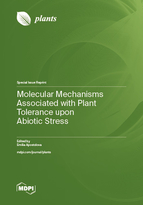Molecular Mechanisms Associated with Plant Tolerance upon Abiotic Stress
A special issue of Plants (ISSN 2223-7747). This special issue belongs to the section "Plant Response to Abiotic Stress and Climate Change".
Deadline for manuscript submissions: closed (15 July 2024) | Viewed by 23554
Special Issue Editor
Interests: abiotic stress; chlorophyll fluorescence; photosynthesis; adaptation of plants; lipid–protein interactions; mechanisms of plant tolerance
Special Issues, Collections and Topics in MDPI journals
Special Issue Information
Dear Colleagues,
Plants in their development are exposed to various abiotic stress factors that have negative effects on plant growth and crop productivity. Stress-induced damage in proteins, lipids and nucleic acids leads to an increased accumulation of reactive oxygen species (ROS), which cause oxidative damage. One process in plants that is strongly affected under stress is photosynthesis. The impact of stress factors on plants depends on their intensity, frequency and duration, as well as the plant species. Plants evolve different adaptation mechanisms to survive the harmful effects of the environment. Studies in past years have revealed that plants have different sensitivities to stress factors. Despite many studies working to elucidate the mechanisms of plant tolerance to abiotic stress factors, the exact mechanisms are not fully understood. Therefore, the study of the influence of abiotic stress factors on the growth, physiology, biochemistry and photosynthesis of different plant species is of great importance in order to clarify the mechanisms of tolerance in plants.
This Special Issue aims to show the molecular mechanisms associated with plant tolerance upon various abiotic stresses, such as salinity, drought, temperature, ultraviolet radiation and heavy metals.
Scientists from all over the world are invited to submit original research and review articles on topics related to plant defense mechanisms.
Prof. Dr. Emilia Apostolova
Guest Editor
Manuscript Submission Information
Manuscripts should be submitted online at www.mdpi.com by registering and logging in to this website. Once you are registered, click here to go to the submission form. Manuscripts can be submitted until the deadline. All submissions that pass pre-check are peer-reviewed. Accepted papers will be published continuously in the journal (as soon as accepted) and will be listed together on the special issue website. Research articles, review articles as well as short communications are invited. For planned papers, a title and short abstract (about 100 words) can be sent to the Editorial Office for announcement on this website.
Submitted manuscripts should not have been published previously, nor be under consideration for publication elsewhere (except conference proceedings papers). All manuscripts are thoroughly refereed through a single-blind peer-review process. A guide for authors and other relevant information for submission of manuscripts is available on the Instructions for Authors page. Plants is an international peer-reviewed open access semimonthly journal published by MDPI.
Please visit the Instructions for Authors page before submitting a manuscript. The Article Processing Charge (APC) for publication in this open access journal is 2700 CHF (Swiss Francs). Submitted papers should be well formatted and use good English. Authors may use MDPI's English editing service prior to publication or during author revisions.
Benefits of Publishing in a Special Issue
- Ease of navigation: Grouping papers by topic helps scholars navigate broad scope journals more efficiently.
- Greater discoverability: Special Issues support the reach and impact of scientific research. Articles in Special Issues are more discoverable and cited more frequently.
- Expansion of research network: Special Issues facilitate connections among authors, fostering scientific collaborations.
- External promotion: Articles in Special Issues are often promoted through the journal's social media, increasing their visibility.
- Reprint: MDPI Books provides the opportunity to republish successful Special Issues in book format, both online and in print.
Further information on MDPI's Special Issue policies can be found here.







